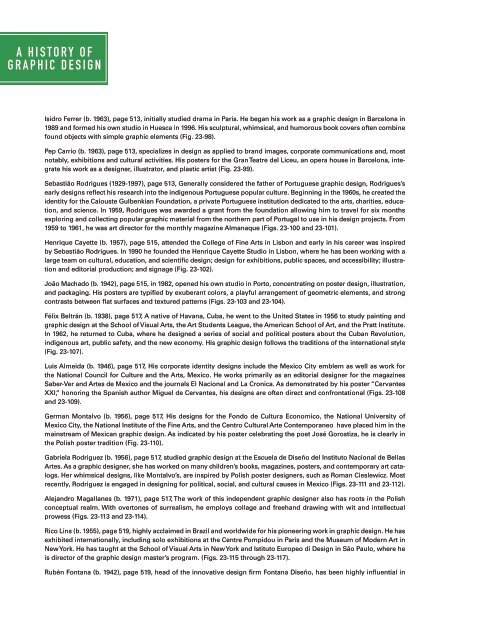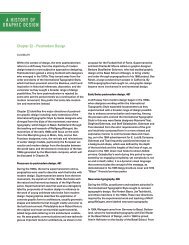Week 2 National Visions within a Global Dialogue - A History of ...
Week 2 National Visions within a Global Dialogue - A History of ...
Week 2 National Visions within a Global Dialogue - A History of ...
Create successful ePaper yourself
Turn your PDF publications into a flip-book with our unique Google optimized e-Paper software.
A HISTORY OFGRAPHIC DESIGNIsidro Ferrer (b. 1963), page 513, initially studied drama in Paris. He began his work as a graphic design in Barcelona in1989 and formed his own studio in Huesca in 1996. His sculptural, whimsical, and humorous book covers <strong>of</strong>ten combinefound objects with simple graphic elements (Fig. 23-98).Pep Carrio (b. 1963), page 513, specializes in design as applied to brand images, corporate communications and, mostnotably, exhibitions and cultural activities. His posters for the Gran Teatre del Liceu, an opera house in Barcelona, integratehis work as a designer, illustrator, and plastic artist (Fig. 23-99).Sebastião Rodrigues (1929-1997), page 513, Generally considered the father <strong>of</strong> Portuguese graphic design, Rodrigues’searly designs reflect his research into the indigenous Portuguese popular culture. Beginning in the 1960s, he created theidentity for the Calouste Gulbenkian Foundation, a private Portuguese institution dedicated to the arts, charities, education,and science. In 1959, Rodrigues was awarded a grant from the foundation allowing him to travel for six monthsexploring and collecting popular graphic material from the northern part <strong>of</strong> Portugal to use in his design projects. From1959 to 1961, he was art director for the monthly magazine Almanaque (Figs. 23-100 and 23-101).Henrique Cayette (b. 1957), page 515, attended the College <strong>of</strong> Fine Arts in Lisbon and early in his career was inspiredby Sebastião Rodrigues. In 1990 he founded the Henrique Cayette Studio in Lisbon, where he has been working with alarge team on cultural, education, and scientific design; design for exhibitions, public spaces, and accessibility; illustrationand editorial production; and signage (Fig. 23-102).João Machado (b. 1942), page 515, in 1982, opened his own studio in Porto, concentrating on poster design, illustration,and packaging. His posters are typified by exuberant colors, a playful arrangement <strong>of</strong> geometric elements, and strongcontrasts between flat surfaces and textured patterns (Figs. 23-103 and 23-104).Félix Beltrán (b. 1938), page 517, A native <strong>of</strong> Havana, Cuba, he went to the United States in 1956 to study painting andgraphic design at the School <strong>of</strong> Visual Arts, the Art Students League, the American School <strong>of</strong> Art, and the Pratt Institute.In 1962, he returned to Cuba, where he designed a series <strong>of</strong> social and political posters about the Cuban Revolution,indigenous art, public safety, and the new economy. His graphic design follows the traditions <strong>of</strong> the international style(Fig. 23-107).Luis Almeida (b. 1946), page 517, His corporate identity designs include the Mexico City emblem as well as work forthe <strong>National</strong> Council for Culture and the Arts, Mexico. He works primarily as an editorial designer for the magazinesSaber-Ver and Artes de Mexico and the journals El Nacional and La Cronica. As demonstrated by his poster “CervantesXXI,” honoring the Spanish author Miguel de Cervantes, his designs are <strong>of</strong>ten direct and confrontational (Figs. 23-108and 23-109).German Montalvo (b. 1956), page 517, His designs for the Fondo de Cultura Economico, the <strong>National</strong> University <strong>of</strong>Mexico City, the <strong>National</strong> Institute <strong>of</strong> the Fine Arts, and the Centro Cultural Arte Contemporaneo have placed him in themainstream <strong>of</strong> Mexican graphic design. As indicated by his poster celebrating the poet José Gorostiza, he is clearly inthe Polish poster tradition (Fig. 23-110).Gabriela Rodriguez (b. 1956), page 517, studied graphic design at the Escuela de Diseño del Instituto Nacional de BellasArtes. As a graphic designer, she has worked on many children’s books, magazines, posters, and contemporary art catalogs.Her whimsical designs, like Montalvo’s, are inspired by Polish poster designers, such as Roman Cieslewicz. Mostrecently, Rodriguez is engaged in designing for political, social, and cultural causes in Mexico (Figs. 23-111 and 23-112).Alejandro Magallanes (b. 1971), page 517, The work <strong>of</strong> this independent graphic designer also has roots in the Polishconceptual realm. With overtones <strong>of</strong> surrealism, he employs collage and freehand drawing with wit and intellectualprowess (Figs. 23-113 and 23-114).Rico Lins (b. 1955), page 519, highly acclaimed in Brazil and worldwide for his pioneering work in graphic design. He hasexhibited internationally, including solo exhibitions at the Centre Pompidou in Paris and the Museum <strong>of</strong> Modern Art inNew York. He has taught at the School <strong>of</strong> Visual Arts in New York and Istituto Europeo di Design in São Paulo, where heis director <strong>of</strong> the graphic design master’s program. (Figs. 23-115 through 23-117).Rubén Fontana (b. 1942), page 519, head <strong>of</strong> the innovative design firm Fontana Diseño, has been highly influential in
















